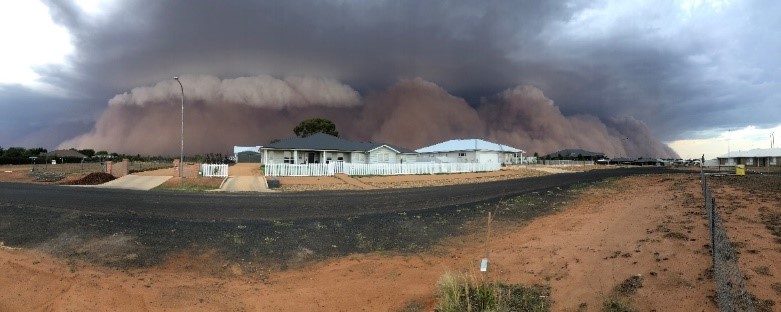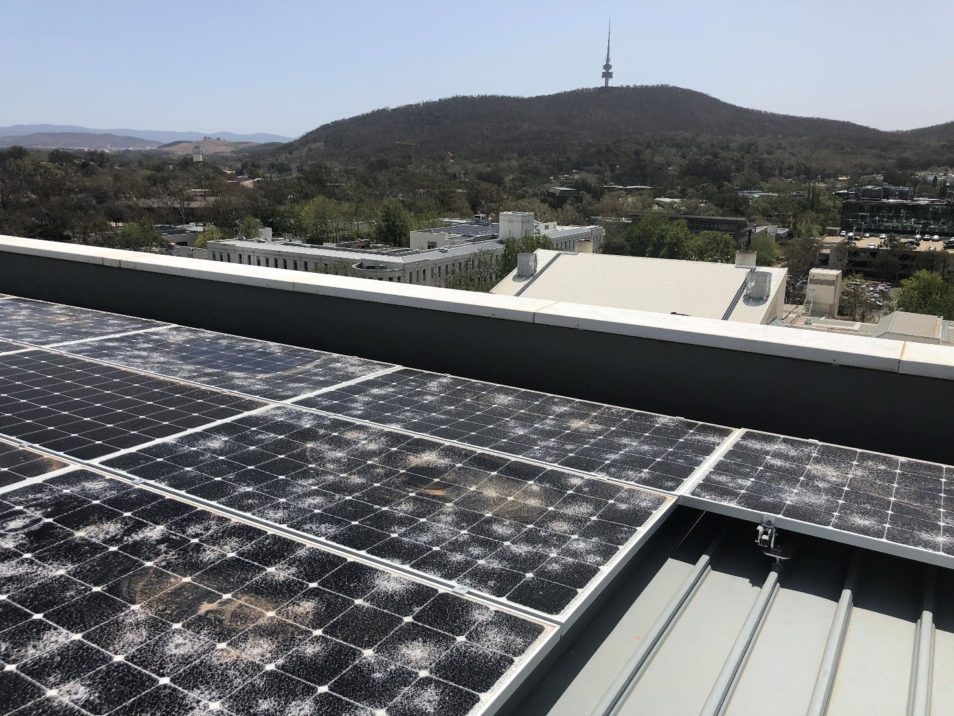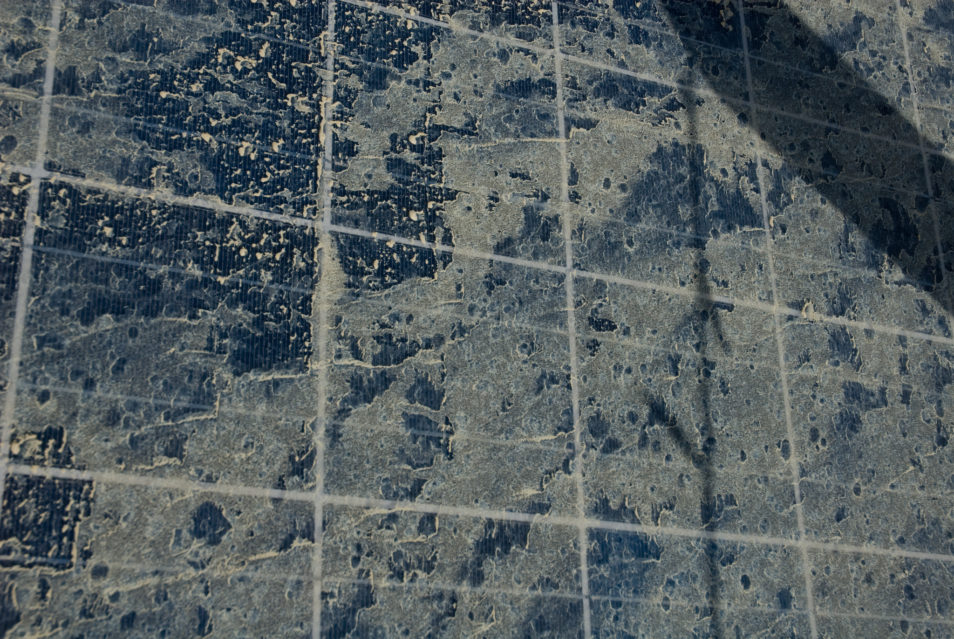
ABC reporter Jen Browning faces the impending dust storm in rural NSW. Image: Jen Browning.
This summer, bushfire smoke has blanketed towns and cities across Australia. Dust storms descended on western New South Wales with clouds “so thick they blocked out the sun!” In Canberra, hailstorms battered cars, houses, greenhouses and solar panels.
So, how do hailstorms, dust storms and smoke affect your solar panel performance? What happens to solar power when you can’t even see the sun? We spoke to our head of Solar Technologies, Dr Greg Wilson, to get some answers.
What happens to solar panel performance when there’s smoke and dust in the air?
“Solar panels take in sunlight and material on the panels’ surface converts sunlight to electrons, which become electricity,” Greg explains.
“Anything that blocks out the sun will reduce the amount of energy your panels produce.”
Bushfire smoke and dust storms can cause elevated particle levels in the atmosphere. Smoke from bushfires is made up of gases, water vapour and particles. These particles are so tiny they’re not visible to the naked eye. The NSW Health Department and EPA estimates some particles are <2.5 micron. That’s about three per cent the diameter of a human hair.
What happens to photovoltaic (PV) capacity on hazy or dusty days?
“It really depends where you are. At our Energy Centre in Newcastle, with an ocean breeze, we still saw significant loss in energy production on hazy days. Our solar panels were down 10 to 30 per cent compared to last year,” Greg says.
“Yet at my home 20 kilometres away, with no ocean breeze, I had 80 per cent reduction in energy output.”
Indeed, solar monitoring company Solar Analytics found rooftop PV systems in Sydney and Canberra plummeted by 15 to 45 per cent on smoky days this summer.

A dust storm hit Dubbo on 20 January 2020. It deposited fine dust reducing electrical output. Image: Andrew Hildebrandt
Does ash from bushfires affect solar panel performance?
“Unless you’re close to fires where embers are falling, ash is just a different type of dust,” Greg says. “Solar panels are not self-cleaning, but debris will wash off when it rains.”
How do hailstorms affect solar panels?
The January hailstorm in Canberra damaged houses, cars and solar panels across the city. This included our Black Mountain Science and Innovation Park. Thankfully no-one was injured, but 65 glasshouses and several solar panels were destroyed.
Solar panels are rated using two class systems. There’s a ‘Severe Hail Damage Resistance Test’, which tests panels for cricket ball-sized hailstones. Most panels are tested according to the ‘Moderate Hail Damage Test’, comprising 25mm hailstones that weigh 7.53 grams.
The hailstones that hit Canberra, in January 2020, were golf ball-sized weighing about 20 grams each. That’s larger than normal conditions for ‘Moderate Hail’ and outside the normal testing parameters for PV panels. As this weather becomes more frequent with climate change, rating systems will need to reflect extreme events. This means we need to improve design of our panels to withstand such conditions.

Hail damage to solar panels in Canberra after the January 2020 hailstorm. Image: Capital solar maintenance.
Should I clean my panels after an extreme weather event?
First of all, work with your installer to ensure your solar system is positioned away from overhanging trees. You’re less likely to encounter bird droppings, sap, power losses due to shading, or an environment where lichen or mould could grow.
For most homes in Australia, rainfall will be enough to keep the solar panels relatively free of debris, meaning there’s no need to have them cleaned. One exception may be in extreme drought conditions, although then you may be under water restrictions anyway.
If you do want to clean your solar system, we recommend consulting a professional (start with your installer), to avoid the risk of personal injury due to falling from the ladder or roof. Falls from ladders are a leading cause of serious injury to people on their properties.
If you insist on doing it yourself, detergent shouldn’t be necessary. Use plain water from a hose or bucket, and a soft brush or mop on a long handle. Patches of lichen or bird droppings can be pre-soaked for easy removal with a scraping tool. Avoid high-pressure cleaners, which can force water inside the panel and will likely void your warranty.

A build-up of dirt and grime can significantly reduce the efficiency of your solar panels. Image: Jesse Wagstaff
A build-up of dirt and grime can significantly reduce the efficiency of your solar panels. Image: Jesse Wagstaff
Be careful of solar panels after an extreme weather event
Greg warns people to be extremely careful when returning to their house after extreme weather events. While the sun is out, your solar PV system will continue generating electricity.
Even with network supply turned off, treat the system and wires as if they are live. If wires have come loose and are touching the roof, it is electrified. Also, if your panels are damaged, you could receive a lethal electric shock turning the system back on.
“Get a licenced electrician or an accredited installer to check that your system is safe. Isolate the PV system electrically before returning to your house,” Greg says.
“Tragically, there are reports of emergency services personnel seriously injured where solar panels are still electrified.”
More information
For more information on how to prepare your house and solar panels before a natural disaster, see these articles by the NSW Government and Clean Energy Council. For information on returning to your house after a natural disaster, read these articles by the Australian Red Cross, Victorian Government, and NSW Government. You can also contact your local emergency services for further advice.


19th March 2020 at 5:15 pm
The information is timely and in easy to understand language. Thanks
19th March 2020 at 4:23 pm
Certainly news to me. I thought solar panels only generated 24V’s DC and that voltages were not lethal in these systems until downstream of the rectifier. ( which is typically indoors)
19th March 2020 at 1:51 pm
Interesting about the small amount of soiling actually aiding performance – good to know.
14th February 2020 at 12:50 pm
Thanks for the info on potential injuries to people helping to deal with roof damage after a storm.
12th February 2020 at 5:24 pm
Thanks for information on Solar panel performance and the weather or conditions that may affect, this information should be regular as panels and systems technology improve.